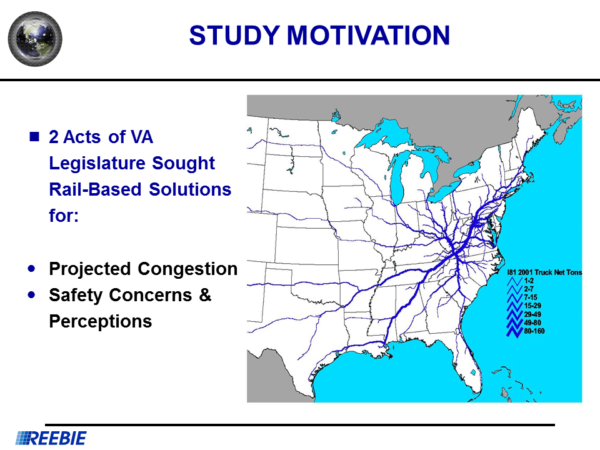Historic Studies done by Reebie Associates in 2003 on I-81/I-95 corridor
A draft report and Powerpoint presentation on a marketing study done in 2003 on the I-81 and I-95 corridor are now available in the Resources Section of this website. The study was done for the Virginia Department of Rail and Public Transportation.
The documents can be accessed from this page.
Summary of content and influence of the documents
The draft report of the “Northeast-Southeast-Midwest Corridor Paralleling I-81 & I-95 Marketing Study,” submitted to the Virginia Department of Rail and Public Transportation by Reebie Associates, (March 31st, 2003, aka Draft Reebie, see PDF), set the standard for the economic assessment of contemporary, North American truck diversion programs. The findings of this preliminary study were presented to the American Society of State Highway and Transportation Officials, Standing Committee on Rail Transportation in September 2003 by Joseph G. Bryan, Reebie Managing Principal, (see slides).
Draft Reebie:
- Identified the sources and types of truck traffic in the I-81 and I-95 corridors.
- Recommended steps to divert substantial truck traffic to the rail mode, sufficient to avoid large-scale roadway capacity expansion.
-
Showed that conventional rail intermodal mainly serves large and super carrier shipments in long-haul lanes, (see slide 6).
- Demonstrated that incremental upgrades to existing interstate rail corridors and implementation of new operating practices would increase truck diversions, and grow railway market share in midrange domestic shipments, (see slide 8).
- Summed up best:
- “Our conclusion is that if substantial diversion of traffic from trucks to NS is to occur in this corridor, NS’s average train speed needs to be increased to approximately 60 mph, or 15 mph faster than average truck speeds of 45 mph, in order to offset the minimum projected terminal time. To do so would require significant track upgrading as well as increasing NS’s maximum authorized speed for intermodal trains to as much as 79 mph, comparable to its existing maximum allowable speed for passenger trains,” page 69, Draft Reebie.
In the fourteen years since 2003, it has been:
- Foundational for the Steel Interstate Coalition, (nee RAIL Solution).
- Referenced in the Wyoming DOT Feasibility of a Next-Generation Intemodal Rail-Truck Transport System for the Western I-80 Corridor: Engineering, Economic, Environmental, Safety and Security Policy Considerations, (see pages 78-80).
- Informed the Nevada DOT Phase II Steel Interstate and Land Ferry Draft Scope of Work.
Follow Us
Share This

Leave a Reply
You must be logged in to post a comment.